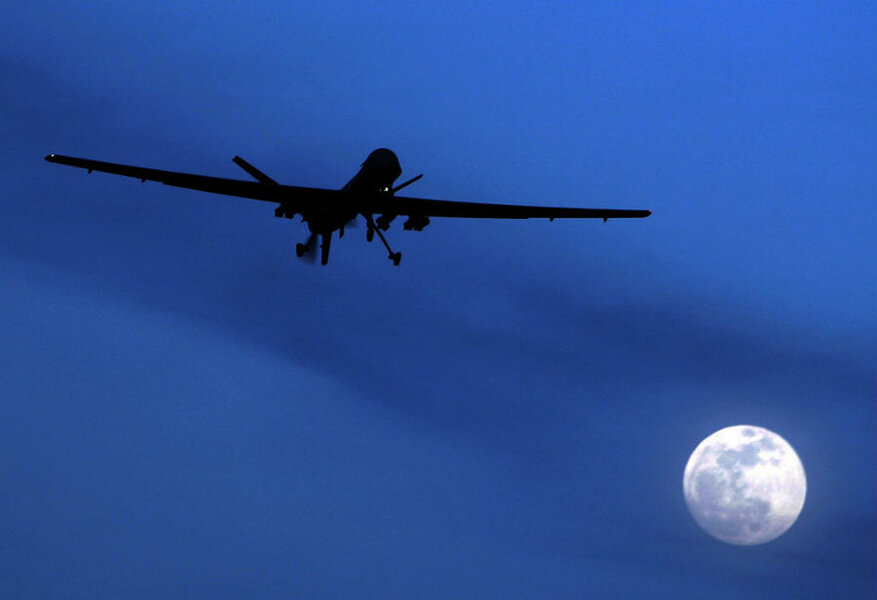Trump to ramp up drone warfare. Will more civilians die?
Loading...
President Trump’s administration has plans to loosen drone warfare restrictions set for the CIA and military, a move that could increase the number of targeted attacks on so-called enemy combatants, as well as increasing the risk of civilian casualties.
The administration says it has nearly completed a review of the current policies and is considering reforms that would make it easier to launch drone strikes against groups like Al Qaeda or the so-called Islamic State. Those changes would require rolling back restrictions put in place by former President Barack Obam that attempted to slow or reverse the accelerating trend of using drones.
As it considers its drone policy, the administration must define the wartime role of the United States: Should the nation primarily retaliate when threatened, or strike proactively against enemy groups?
“Are people going after [targets] because they are posing an immediate threat to the US homeland? Or is it the sense that this is a dangerous group?” asks Daniel Byman, a Georgetown University professor of foreign service and government, in a phone interview with The Christian Science Monitor.
“It’s always easy to say, on the one hand, you want to lay the groundwork," he says. "On the other hand, there’s those who argue the US shouldn’t try to be involved everywhere.”
The policy review, now before senior members of the National Security Council, would overturn the rules Mr. Obama rolled out from 2013 to 2016, including the Presidential Policy Guidance and a 2016 executive order, The Washington Post reported.
Those include rules that mandate any drone strike attempted outside of a war zone must undergo scrutiny to ensure a “near certainty” that no civilians will be harmed and that an immediate strike is necessary to protect Americans. Measures also require the military or CIA to notify the White House when delivering strikes against high-profile targets.
Those rules, along with a diminishing threat in Pakistan, did lead to the intended drop in strikes. But some military personnel argue that the regulations make it harder to fire at targets, and that waiting for approval can cause delays that lead them to lose sight of people identified as enemies.
The Trump administration is considering allowing CIA and military personnel to target and kill Al Qaeda and IS militants without the president’s authority in nations such as Yemen, Somalia, Iraq, Syria, Libya, and Afghanistan, sources confirmed to NBC.
"A big goal is getting the White House out of the way of itself," said a senior US official to the Washington Post. "The president believes too much has been centralized in the White House and he wants to push decisions down to the agencies."
Requiring an “imminent” threat to the US before striking has also raised concerns. Some military experts say the threshold prevents the US from assisting its allies when terrorist groups pose a threat to them, sending an isolationist message.
Obama’s tenure was marked by a dramatic increase in drone use. His predecessor, former President George W. Bush, issued around 50 targeted attacks. Obama deployed more than 400 unmanned aerial devices that killed more than 2,000 people designated as enemy combatants and an estimated 116 noncombatants.
Last summer, Obama's drone legacy shifted as he signed an executive order that levied additional restrictions against such action. Worried that future leaders would be lured by the convenience of drones, which have low costs both financially and in manpower, Obama sought to set a precedent that contradicted his own actions.
"We have to create an architecture for this because [of] the potential for abuse," Obama said during a speech in August.
But critics have debated whether Obama was sharing lessons learned through experience or simply trying to please opponents of his drone policies during his administration's waning hours.
Still, human rights activists praised the move, saying that preventing civilian death is not only an ideal the US should strive for as an ethical world leader, but that it also helps military operations to achieve their goals faster.
Large numbers of civilian deaths impact public opinion, both at home and abroad, and can encourage locals to turn against the US and heed the calls of terror recruiters.
So what, if anything, has changed?
“The large question it raises is why, given the strategic value of preventing civilian harm, the military would want to see the rules watered down?” asks Dan Mahanty, the senior adviser for the Center for Civilians in Conflict’s US Program and former leader of the State Department's Office of Security and Human Rights in the Bureau of Democracy, Human Rights and Labor, in an interview with the Monitor.
The Obama administration's policies “reflected very much the reality of minimizing harm to civilians, [which] serves the longer-term strategic interest of the US," says Mr. Mahanty. "It kind of overlooks a bigger concern, which is the expansion of conflict to many more places in the world.”
For now, it’s unclear how many drone regulations Mr. Trump intends to overturn. But Mahanty and other civilian advocates continue to stress the importance – and benefits – of ensuring that military operations steer clear of innocent bystanders.
If the US military wants to shift how its military tactics are perceived around the world, Mahanty says, lifting restrictions on drone strokes would be a "tremendous setback."
This report contains material from the Associated Press.








